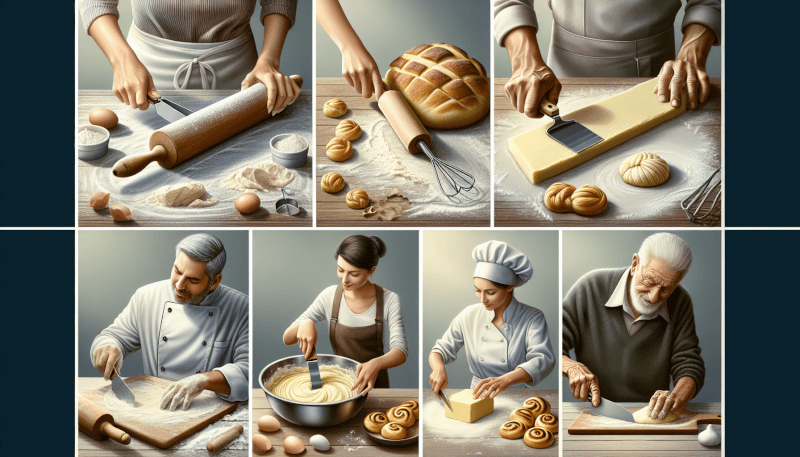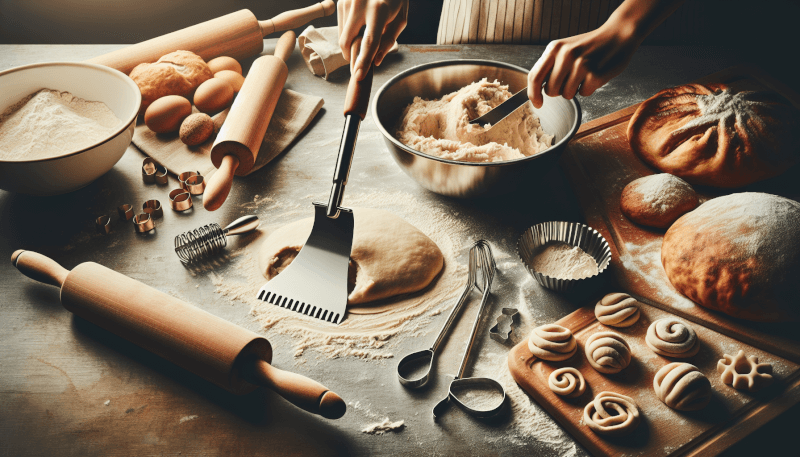If you’re an avid baker or even just a casual home baker, you may have come across a dough scraper in your baking supplies. But do you know how to use it properly? A dough scraper is a versatile tool that can greatly improve your baking experience. In this article, we will explore the various ways you can use a dough scraper to make your baking endeavors easier and more efficient. From dividing and portioning dough to cleaning up sticky surfaces, a dough scraper is a must-have tool in any baker’s arsenal. So, whether you’re a seasoned pro or just starting out, let’s dive into the world of dough scrapers and discover the many ways they can enhance your baking adventures.

What is a Dough Scraper?
A dough scraper, also known as a bench scraper or a pastry scraper, is a versatile tool used in baking and cooking. It is typically a flat, rectangular or curved piece of metal or plastic with a handle on one end. The purpose of a dough scraper is to assist in various tasks during the dough-making process, such as gathering ingredients, mixing and kneading, dividing and shaping, and cleaning up.
Choosing the Right Dough Scraper
When it comes to selecting the right dough scraper for your baking needs, there are a few factors to consider.
Consider the Material
Dough scrapers are available in various materials, including stainless steel and food-grade plastic. Stainless steel scrapers are durable, easy to clean, and can withstand high temperatures, making them suitable for professional bakers or frequent home bakers. On the other hand, plastic scrapers are lighter, more affordable, and ideal for occasional baking.
Size and Shape
Dough scrapers come in different sizes and shapes, so it’s important to choose one that suits your needs. The size of the scraper should depend on the amount of dough you typically work with. If you often bake in larger batches, a larger scraper would be more efficient. As for the shape, a rectangular scraper is versatile and can be used for a variety of tasks, while a curved scraper is great for tackling rounded dough.
Ergonomics
Since you’ll be using the dough scraper for extended periods, it’s essential to consider its ergonomics. Look for a scraper with a comfortable handle that provides a good grip. Some scrapers come with textured or non-slip handles, which can be especially helpful when your hands are covered in dough.
Additional Features to Look for
Some dough scrapers come with additional features that can enhance your baking experience. For example, some scrapers have measurement markings on the edges, which can be useful when portioning dough. Others have a flexible blade, which makes it easier to scrape every last bit of dough from the bowl. Consider these additional features and choose a scraper that aligns with your needs.

Preparing Your Dough
Before delving into the uses of a dough scraper, it’s important to understand how to properly prepare your dough for baking. This involves a few key steps.
Gathering Ingredients
Start by gathering all the ingredients needed for your dough recipe. This typically includes flour, water, yeast, salt, and any additional flavorings or add-ins. Having all your ingredients measured and easily accessible will help streamline the dough-making process.
Mixing and Kneading
Once the ingredients are gathered, you’ll need to mix and knead the dough to develop gluten and achieve the desired texture. This involves combining the ingredients and working the dough until it becomes smooth and elastic. Mixing and kneading techniques may vary depending on the recipe, but a dough scraper will come in handy during this process.
Dividing and Shaping
After the dough has been mixed and kneaded, it may need to be divided and shaped according to your baking intentions. This could involve portioning the dough into individual pieces for rolls or forming it into a specific shape, such as a loaf or a pizza crust. A dough scraper can assist in these tasks, making the process more efficient and precise.
Using a Dough Scraper for Mixing and Kneading
A dough scraper can be a valuable tool when it comes to mixing and kneading your dough. Here’s how you can utilize it effectively.
Scraping the Bowl
When mixing your dough ingredients in a bowl, there may be some stubborn remnants sticking to the sides or the bottom. A dough scraper can be used to scrape the bowl, ensuring that all the ingredients are fully incorporated and preventing any wasted dough.
Incorporating Ingredients
During the mixing process, you may encounter situations where ingredients are not evenly distributed. A dough scraper can be used to fold the dough over itself, helping to evenly distribute ingredients and ensure a consistent texture. This scraping and folding technique can be particularly useful when working with sticky or wet dough.
Folding and Turning
Kneading the dough involves folding and turning it to develop gluten. A dough scraper can aid in this process by helping to lift and fold the dough onto itself. This technique creates layers within the dough, resulting in better texture and structure. The scraper can also be used to turn the dough, ensuring that all sides are evenly kneaded.

Dividing and Shaping with a Dough Scraper
Once your dough is mixed and kneaded to perfection, it’s time to divide and shape it. Here’s how a dough scraper can assist you in these tasks.
Cutting the Dough
When dividing your dough into individual portions, a dough scraper can be used as a precise cutting tool. Its straight edge allows for clean cuts, ensuring that each portion is uniform in size. This is especially important when baking items like rolls or pastries that need to be of equal size for even baking.
Dividing into Portions
After cutting the dough, a dough scraper can be used to separate and move the individual portions. This helps prevent sticking and allows for easy transfer to a baking sheet or other surface. The scraper’s flat surface also allows you to lift and transfer portions without deforming their shape.
Shaping the Dough
Shaping the dough into the desired form, such as a loaf or a round shape, is made easier with the help of a dough scraper. Its flat, flexible edge can be used to gently lift and fold the dough, creating tension and structure. Whether you’re making a baguette or a specialty bread, the dough scraper can be an invaluable tool in achieving the desired shape.
Cleaning and Maintaining Your Dough Scraper
Proper cleaning and maintenance of your dough scraper are essential for not only prolonging its lifespan but also ensuring food safety. Here are some tips on keeping your dough scraper in good condition.
Proper Cleaning Techniques
After each use, make sure to clean your dough scraper thoroughly. For metal scrapers, use warm soapy water to remove any dough residue. Plastic scrapers can be cleaned in the same way or can even be put in the dishwasher for convenience. Pay special attention to the corners and edges to ensure all dough particles are removed.
Storage and Maintenance Tips
To maintain the integrity of your dough scraper, store it in a clean and dry place. Avoid storing it with other utensils that could damage or scratch the scraper’s surface. Additionally, periodically check for any signs of wear or damage, such as cracks or bent edges. If you notice any issues, it may be time to replace your dough scraper to ensure safe and efficient baking.

Alternative Uses for a Dough Scraper
While a dough scraper is primarily designed for dough-related tasks, it can also be utilized in other ways in the kitchen. Here are some alternative uses for a dough scraper.
Cleaning Work Surface
After kneading dough or working with sticky ingredients, your work surface may be covered in residue. A dough scraper can be used to easily and efficiently scrape off any dough or other debris from your countertop or cutting board. Its flat edge is perfect for removing stubborn bits that would otherwise require more effort to clean.
Transferring Chopped Ingredients
When chopping fruits, vegetables, or herbs, a dough scraper can be helpful in transferring the ingredients from the cutting board to a bowl or a pan. Instead of using your hands or a knife, simply scoop up the chopped ingredients with the scraper and release them where you want them to go. This minimizes the risk of cutting yourself and makes the transfer process more efficient.
Measuring Ingredients
Some dough scrapers come with measurement markings on their edges, allowing you to measure ingredients directly on the scraper. This can be especially handy when portioning or dividing dough, as you can easily see if each portion is the desired size. It eliminates the need for additional measuring tools, making your baking process smoother and more streamlined.
Tips and Tricks for Efficient Dough Scraping
To make the most out of your dough scraper, here are some tips and tricks to keep in mind.
Use Light Pressure
When using a dough scraper, it’s important to apply gentle pressure. Using excessive force can not only damage the scraper but also potentially affect the texture of the dough. Let the sharp edge and the natural weight of the scraper do the work for you.
Maintain a Proper Angle
To maximize efficiency, hold the dough scraper at a slight angle towards the dough. This allows the edge to effectively scrape and lift the dough, making it easier to work with. Experiment with different angles to find the most comfortable and effective position for your specific task.
Work in Sections
When working with a large batch of dough, it can be overwhelming to tackle all of it at once. Instead, divide the dough into manageable sections and work on each portion separately. This allows for more control and prevents the dough from sticking to the scraper or your hands.
Let the Dough Rest
During the dough-making process, it’s essential to give the dough resting periods. This allows gluten to relax and the dough to rise properly. When using a dough scraper, take breaks to let the dough rest and recover. This will make it easier to handle and shape without resistance.

Common Mistakes to Avoid
While a dough scraper is a helpful tool, there are some common mistakes to avoid for a successful baking experience.
Using Excessive Force
As mentioned earlier, using excessive force with a dough scraper can be counterproductive. Avoid applying too much pressure, as this can damage the scraper or negatively impact the texture of the dough. Instead, rely on the sharp edge and your own posture to efficiently scrape and handle the dough.
Neglecting to Clean Properly
Proper cleaning and maintenance of your dough scraper are crucial for food safety. Neglecting to clean the scraper thoroughly can lead to the buildup of bacteria or other contaminants. Take the time to clean the scraper after each use, paying attention to all corners and edges to ensure a hygienic baking environment.
Using a Dull or Damaged Scraper
Over time, your dough scraper may become dull or damaged. It’s important to replace it when necessary to ensure safe and effective baking. A dull or damaged scraper can hinder your baking process and potentially introduce unwanted elements into your dough.
Conclusion
A dough scraper is a versatile tool that should find a place in every baker’s kitchen. From mixing and kneading to dividing and shaping, it assists in various stages of the dough-making process. By choosing the right scraper, understanding its uses, and following proper techniques, you can elevate your baking experience and achieve outstanding results. So, next time you embark on your baking adventure, don’t forget to grab your trusty dough scraper and enjoy the benefits it brings to your dough preparation. Happy baking!


